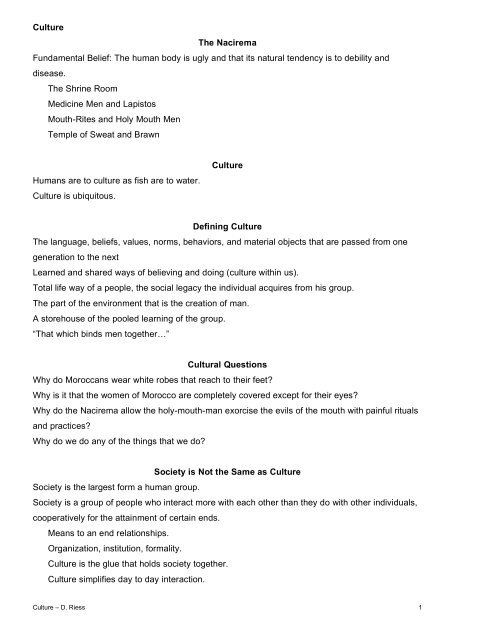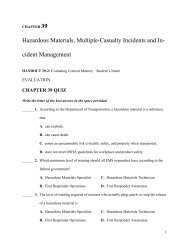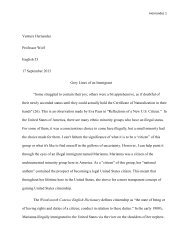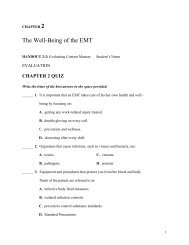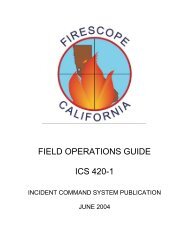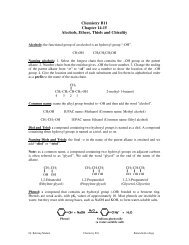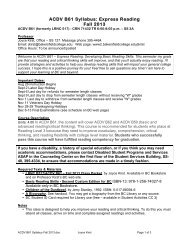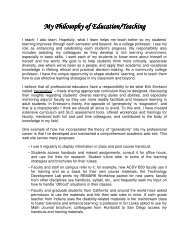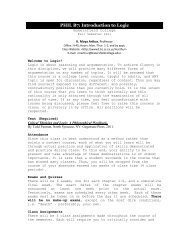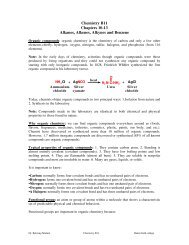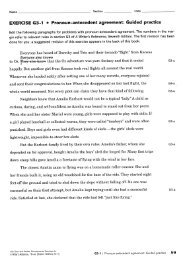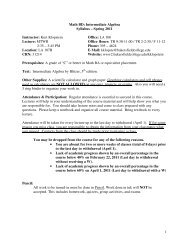Culture The Nacirema Fundamental Belief: The human body is ugly ...
Culture The Nacirema Fundamental Belief: The human body is ugly ...
Culture The Nacirema Fundamental Belief: The human body is ugly ...
You also want an ePaper? Increase the reach of your titles
YUMPU automatically turns print PDFs into web optimized ePapers that Google loves.
<strong>Culture</strong><br />
<strong>The</strong> <strong>Nacirema</strong><br />
<strong>Fundamental</strong> <strong>Belief</strong>: <strong>The</strong> <strong>human</strong> <strong>body</strong> <strong>is</strong> <strong>ugly</strong> and that its natural tendency <strong>is</strong> to debility and<br />
d<strong>is</strong>ease.<br />
<strong>The</strong> Shrine Room<br />
Medicine Men and Lap<strong>is</strong>tos<br />
Mouth-Rites and Holy Mouth Men<br />
Temple of Sweat and Brawn<br />
Humans are to culture as f<strong>is</strong>h are to water.<br />
<strong>Culture</strong> <strong>is</strong> ubiquitous.<br />
<strong>Culture</strong><br />
Defining <strong>Culture</strong><br />
<strong>The</strong> language, beliefs, values, norms, behaviors, and material objects that are passed from one<br />
generation to the next<br />
Learned and shared ways of believing and doing (culture within us).<br />
Total life way of a people, the social legacy the individual acquires from h<strong>is</strong> group.<br />
<strong>The</strong> part of the environment that <strong>is</strong> the creation of man.<br />
A storehouse of the pooled learning of the group.<br />
“That which binds men together…”<br />
Cultural Questions<br />
Why do Moroccans wear white robes that reach to their feet<br />
Why <strong>is</strong> it that the women of Morocco are completely covered except for their eyes<br />
Why do the <strong>Nacirema</strong> allow the holy-mouth-man exorc<strong>is</strong>e the evils of the mouth with painful rituals<br />
and practices<br />
Why do we do any of the things that we do<br />
Society <strong>is</strong> Not the Same as <strong>Culture</strong><br />
Society <strong>is</strong> the largest form a <strong>human</strong> group.<br />
Society <strong>is</strong> a group of people who interact more with each other than they do with other individuals,<br />
cooperatively for the attainment of certain ends.<br />
Means to an end relationships.<br />
Organization, institution, formality.<br />
<strong>Culture</strong> <strong>is</strong> the glue that holds society together.<br />
<strong>Culture</strong> simplifies day to day interaction.<br />
<strong>Culture</strong> – D. Riess 1
Consequences of Globalization<br />
<strong>Culture</strong> Shock<br />
Personal d<strong>is</strong>orientation when experiencing an unfamiliar way of life.<br />
Cultural Lag<br />
Period of maladjustment when nonmaterial culture struggles to adapt to new material<br />
conditions.<br />
Cultural Diffusion<br />
Spread of information from other cultures.<br />
Material culture spreads more easily by compar<strong>is</strong>on.<br />
<strong>The</strong> transm<strong>is</strong>sion of non-material culture can result in alternative meanings.<br />
Cultural Leveling<br />
Differences between cultures are less d<strong>is</strong>cernable.<br />
Culturally Standardized Unreason<br />
Equally non-rational responses to the meanings attached to cultural norms.<br />
How many wives should a husband have<br />
What meat will you eat<br />
What relationships are appropriate or inappropriate<br />
Ethnocentr<strong>is</strong>m<br />
One’s own group <strong>is</strong> the center of everything, and all others are scaled and rated with reference to<br />
it.<br />
Toward Own Group<br />
See members as virtuous and superior.<br />
See own values as universal and<br />
intrinsically true.<br />
See own customs as original and centrally<br />
<strong>human</strong>, as reflecting true “<strong>human</strong><br />
nature”.<br />
Toward Outsiders<br />
See outsiders as contemptible, immoral,<br />
and inferior.<br />
See outsiders’ values as false.<br />
See outsiders’ customs as suspicious,<br />
ignorant, and lacking in <strong>human</strong>ity.<br />
Conflict theor<strong>is</strong>ts: ethnocentric value judgments serve to devalue groups and to deny equal<br />
opportunities<br />
Functional<strong>is</strong>ts: ethnocentr<strong>is</strong>m maintains sense of solidarity<br />
<strong>Culture</strong> – D. Riess 2
Cultural Relativ<strong>is</strong>m<br />
You can only understand others and their ways of doing things within their cultural context.<br />
Emphas<strong>is</strong> on understanding.<br />
Sociolog<strong>is</strong>ts are not in the business of reporting that one way of doing things (culturally<br />
speaking) <strong>is</strong> better than another.<br />
Which way <strong>is</strong> better or worse <strong>is</strong> not a sociological question.<br />
That <strong>is</strong> a question for policy makers, social reform<strong>is</strong>ts, and social workers.<br />
Material <strong>Culture</strong><br />
Tangible<br />
Human made from raw materials.<br />
Artifacts / Artificial<br />
What would a culture from another time and/or place say about us based on our material culture<br />
Intangible<br />
Symbols<br />
Language<br />
Norms<br />
Mores<br />
Taboos<br />
Sanctions<br />
<strong>Belief</strong>s, Ideology, Values<br />
Non-Material <strong>Culture</strong><br />
Symbols<br />
Anything that carries a particular meaning recognized by people who share a culture.<br />
Anything that represents something else.<br />
Gestures<br />
Language<br />
Sapir-Whorf Hypothes<strong>is</strong><br />
Language precedes thought.<br />
Language <strong>is</strong> not a given.<br />
Language <strong>is</strong> culturally determined.<br />
Language colors the ways in which we see our world.<br />
<strong>Culture</strong> – D. Riess 3
Spoken or written words and gestures.<br />
Governed by a set of rules (grammar and syntax).<br />
Without rules we would have trouble understanding one another.<br />
Language<br />
So prey I God that non myswrite the,<br />
Ne the mysmetre for defaute of tonge.<br />
And red wher-so thou be, or elles song,<br />
That thou be understode…<br />
-Chaucer<br />
Language Continued….<br />
<strong>The</strong> meanings for the adjective “black” in the dictionary:<br />
D<strong>is</strong>mal, gloomy, forbidding, destitute of moral light or goodness, atrocious, evil, threatening,<br />
clouded with anger.<br />
<strong>The</strong> meanings for the adjective “white” in the dictionary:<br />
Pure or innocent.<br />
Consider “blackl<strong>is</strong>ts” and “white lies”.<br />
Consider gender.<br />
Mailman, policeman, fireman.<br />
M<strong>is</strong>s, Mrs., Ms. vs. Mr.<br />
Princess, softball, powderpuff, women’s tenn<strong>is</strong>, women’s golf, etc.<br />
<strong>The</strong> emergence of non-sex<strong>is</strong>t terms in spite of res<strong>is</strong>tance to such terms.<br />
Norms<br />
Folkways – Casual Norms.<br />
Sanctions may be a dirty look, a roll of the eyes, or d<strong>is</strong>approving comment.<br />
Mores – <strong>The</strong>se Are Not Casual.<br />
Violations can result in a full range of serious sanctions up to and including death.<br />
Taboos – <strong>The</strong> thought of violating these norms <strong>is</strong> upsetting to people.<br />
Sanctions and Structure<br />
Sanctions are the way society perpetuates desired behavior and attempts to extingu<strong>is</strong>h<br />
undesirable behavior.<br />
Sanctions function to maintain societies structure by (+) reinforcing desirable norms and (-)<br />
reacting to deviance.<br />
<strong>Culture</strong> – D. Riess 4
<strong>Belief</strong>s, Ideology, & Values<br />
<strong>Belief</strong>s – specific ideas that people hold to be true.<br />
Ideology – ideas found in law, religion, literature, and the arts used by upper classes to maintain<br />
their superiority.<br />
Values - culturally defined standards that people use to decide what <strong>is</strong> desirable, good, and<br />
beautiful and that serve as broad guidelines for social living.<br />
Key Values of U.S. <strong>Culture</strong><br />
1. Individual achievement and personal success.<br />
2. Individual<strong>is</strong>m.<br />
3. Hard work.<br />
4. Efficiency and practicality.<br />
5. Science and technology.<br />
6. Material comfort.<br />
7. Freedom.<br />
8. Democracy and free enterpr<strong>is</strong>e.<br />
9. Equality.<br />
10. Group superiority.<br />
Robin Williams Jr. (1970)<br />
Further Values<br />
Education<br />
Religiosity<br />
Romantic Love<br />
Value Clusters<br />
Le<strong>is</strong>ure<br />
Self-fulfillment<br />
Physical fitness<br />
Youthfulness<br />
Concern for the environment<br />
Further Values and Clusters<br />
Our Changing <strong>Culture</strong><br />
Technology<br />
Knowledge / tools that people use to make a way of life in their surroundings.<br />
Overview of Technology<br />
Hunting and Gathering<br />
Simple tools to hunt animals and gather vegetation.<br />
<strong>Culture</strong> – D. Riess 5
Horticulture and Pastoral<strong>is</strong>m<br />
Using tools to cultivate crops and the domestication of animals.<br />
Agriculture<br />
Large-scale cultivation; control over the earth.<br />
Industry<br />
Factories, energy, efficiency, production, etc.<br />
Postindustrial<br />
Ideas and information<br />
<strong>Culture</strong> in Action – 1<br />
<strong>Culture</strong> as a Product of Action<br />
Every society has problems to be solved.<br />
Solutions are created by <strong>human</strong>s.<br />
<strong>Culture</strong> in Action – 2<br />
<strong>Culture</strong> as a Conditioning Element of Further Action<br />
Once a problem <strong>is</strong> solved in a sat<strong>is</strong>factory way, people stick with<br />
that solution.<br />
<strong>Culture</strong> puts us all in the same rut.<br />
<strong>Culture</strong> in Action – 3<br />
Cultural Maintenance<br />
Once something <strong>is</strong> institutionalized there <strong>is</strong> ordinarily great res<strong>is</strong>tance to change.<br />
Our institutions represent:<br />
“Our Sacred <strong>Belief</strong>s”<br />
that are beyond critic<strong>is</strong>m.<br />
To suggest modification or res<strong>is</strong>tance <strong>is</strong> to threaten our very way of life.<br />
<strong>Culture</strong> – D. Riess 6
Sub and Counter-<strong>Culture</strong>s<br />
Subculture<br />
Values, beliefs, and/or use of material culture set them apart from others in society.<br />
Counterculture<br />
Values, beliefs, and/or behavior are set or positioned against society.<br />
<strong>Culture</strong> Through the Paradigms<br />
Functional<strong>is</strong>t Paradigm<br />
Reinforce societal standards.<br />
<strong>Culture</strong> reinforces solidarity.<br />
Conflict Paradigm<br />
People in different social classes have different values, beliefs, and behavioral norms which<br />
are passed down through socialization.<br />
For most these values, beliefs, and behavioral norms are incompatible with success in society.<br />
Symbolic Interaction<strong>is</strong>t<br />
<strong>Culture</strong> dictates / directs interaction.<br />
Interaction defines, shapes, and <strong>is</strong> shaped by culture.<br />
<strong>Culture</strong> – D. Riess 7


